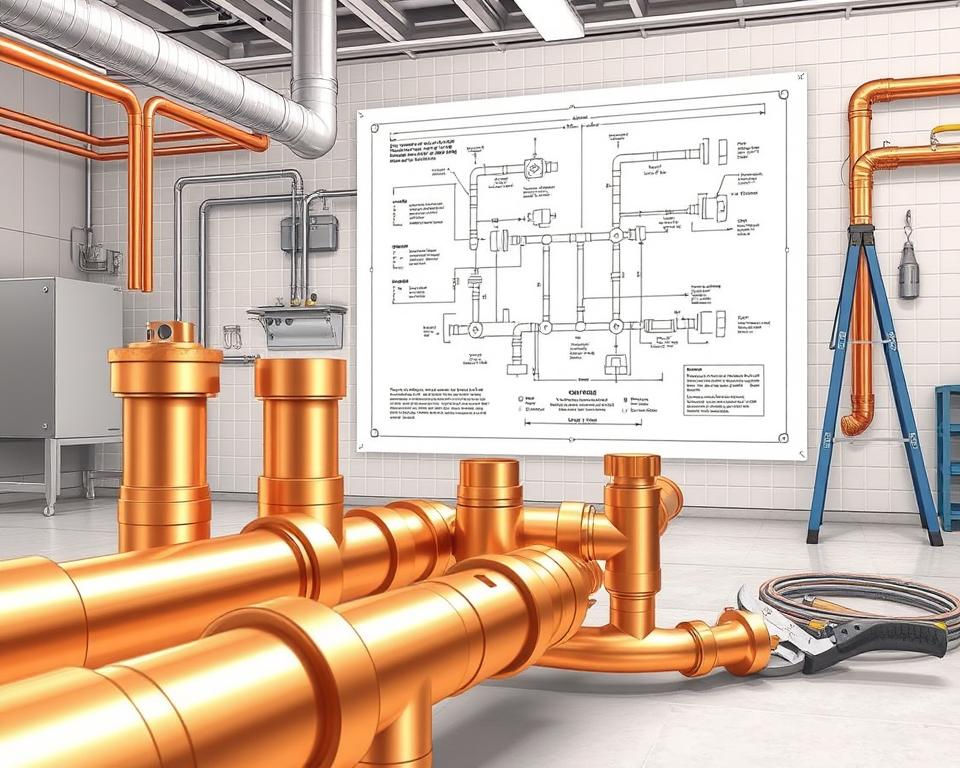Copper Gas Line Installation & Protection Guide
Did you know approximately 90% of supply shops cut and prepare and thread black iron pipe at a supplementary cost? This piece of data shows the strong demand and easy access to gas piping materials, especially copper gas lines. Many homes now favor copper for its robustness, reliability, and rust resistance. This compendium will discuss the basics of copper gas lines, their benefits, and essential safety protocols for installation. With insights from Installation Parts Supply, you’ll learn important aspects of gas line installation. This knowledge secures both protection and adherence to codes while fulfilling your gas piping requirements.
Primary Conclusions
- Copper gas lines offer longevity and corrosion resistance.
- Fitting requires proper measurements and following local building codes.
- Protective steps are vital for ensuring leak-free gas lines.
- Grasping the accurate routing and positioning is crucial for efficient fitting.
- Routine upkeep increases the lifespan of copper gas lines.
Understanding the Essentials of Copper Gas Lines
Copper gas lines are popular in both home and commercial settings. They’re valued for safety and dependability. Studying 5 8 copper gas line, covering their benefits and comparing them with alternative materials, is crucial. This understanding enables homeowners to make well-informed choices.
How would you define a Copper Gas Line?
A copper gas line uses copper piping for natural gas and propane distribution. It complies with established codes like the National Fuel Gas Code (NFPA 54/ANSI Z223.1). In areas such as Minnesota and Florida, it ranks as the leading option in home fuel gas piping. From 1999 onward, organizations including IAPMO have approved its use in fuel gas systems.
Advantages of Employing Copper Gas Lines
Copper gas lines deliver several primary merits. They include:
- Corrosion Resistance: Copper excels over steel and black iron in combating corrosion.
- Flexibility: The malleability eases installation, even in complex layouts.
- Durability: Copper gas lines boast extended lifespan and robust construction, needing fewer replacements.
- Safety: Following stringent protocols, copper tubing proves reliable in gas distribution.
Comparison with Other Materials
In contrasting copper and steel for gas lines, copper often prevails. Black iron pipes are still prevalent, especially in metropolises such as Chicago. However, copper’s reduced weight and ease of handling have increased its usage. Even though nearly half of gas companies opt for stainless steel because of regulatory requirements, copper’s advantages remain significant in certain situations. This is especially true in areas like St. Louis, where newer homes frequently feature copper gas lines.
| Required Materials | Tools for Copper Gas Line Fitting |
|---|---|
| Copper tubing (Type K and Type L) | Pipe wrenches |
| Adapters and joints | Copper cutter |
| Plumber’s tape | Soldering kit |
| Protective equipment (gloves, goggles) | Pressure gauge |
Optimal Methods for Copper Gas Line Setup
Installing copper gas lines entails specific best practices to maintain protection and productivity. Primary elements of the process comprise accurate planning of routes, firm attachments, and rigorous leak tests. These steps ensure a gas piping system that is both secure and compliant.
Placement and Routing for Copper Gas Lines
Thoughtful planning is essential when placing copper gas lines. It is necessary to keep these lines separated from structural features that could inflict harm. This strategy avoids galvanic corrosion by avoiding contact with different metals. Also, ensuring readily accessible routes for future upkeep and fixes is a must by maintaining clearances.
Adhering to these placement and routing standards enhances the system’s safety and robustness.
Joining and Sealing Pipes Properly
Making secure connections in copper gas pipes requires particular supplies. Employ gas-grade plumber’s tape and gas-specific sealants only. Steer clear of regular thread seal tape to avoid leaks from thread oils. By adhering to proper attachment and sealing methods, risks of gas leaks are significantly reduced, in accordance with safety and regulatory standards.
Leak Testing Post-Installation
Post-installation, conducting a thorough leak test is critical. Start with a pressure test, using 1.5 times the system’s peak operating pressure for no less than 10 minutes. Alternatively apply soapy water to expose leaks if bubbles form. The desired pressure for these tests should be around 9 inches w.c., with a minor deviation permitted. These leak detection techniques are fundamental in ensuring the safety of the gas system, which safeguards property and human life.
Copper Gas Line Code Requirements
Understanding and adhering to the multiple standards and codes is vital for copper gas line safety. These rules are fundamental for ensuring compliance and mitigating risks such as leaks and failures. Both homeowners and contractors need to strictly adhere to local building codes. They must obtain the required permits before initiating any installation projects.
Understanding Local Code Requirements
Local building codes establish the rules for installing copper gas lines. They cover issues like installation depth, necessary bracing, and corrosion prevention measures. For underground pipes, there is usually a requirement for 18 inches of burial. However, in some situations, this can be lowered to 12 inches. Steel sleeves are also often required for copper tubing that goes through wall plates near open edges.
Review and Adherence
Regular inspections by qualified experts are vital for gas line safety. They ensure that installations adhere to both the National Fuel Gas Code and local building codes. These inspections check whether copper pipes are firmly installed and if holes made in joists are the correct size. Adhering to these criteria improves safety and guarantees dependable function of gas line installations over time.
Addressing Common Concerns with Copper Gas Lines
Copper gas lines, known for their durability, face corrosion issues. It’s crucial to understand potential problems and necessary upkeep to guarantee safety. Identifying signs of corrosion and the benefits of regular maintenance can stop gas leaks. This knowledge alongside comparing copper to steel gas lines helps decide the best material use.
Copper Gas Line Corrosion Issues
Over time, copper gas lines may deteriorate due to environmental influences or installation errors. Telltale signs include color changes, peeling, and surprising increases in gas bills. Such damage can lead to gas leaks, as evidenced by a sulfur odor from added mercaptan. After construction or excavation, checking for visible damage is crucial.
Maintaining Your Copper Gas Line
For safety and efficiency, upkeeping copper gas lines is essential. Annual inspections can detect early corrosion and issues. Keeping appliances clean and well-ventilated prevents gas buildup and carbon monoxide dangers. Only qualified experts should manage repairs and installations, guaranteeing safety code compliance and minimizing risks of failure.
Copper Gas Line vs. Steel: Pros and Cons
Deciding between copper and steel gas lines requires evaluating advantages and disadvantages. Copper’s malleability simplifies setup in confined areas and typically provides superior corrosion resistance. In comparison, steel lines may offer greater longevity and be more economical for some projects. Considering these aspects aids in choosing the right material for your needs.
To Conclude
The importance of following optimal methods for copper gas installation is paramount. Adherence to safety standards and local codes ensures effective performance and security. The guide also underscores copper gas lines’ advantages, such as robustness and corrosion resistance. However, it’s vital to remain informed about material-related advancements.
Maintenance is critical to the longevity and function of copper gas lines. Correct setup and routine evaluations mitigate risks of corrosion and operational failures. Being informed about local code changes is crucial to prevent penalties or expensive fixes for non-compliance.
Opt for expert advice for copper gas line projects as it is greatly beneficial. Installation Parts Supply offers in-depth information and backing. They ensure your project aligns with all safety standards, enhancing your system’s security and dependability.
Frequently Asked Questions
What is a copper gas line?
A copper gas line is a kind of piping for gas distribution. It’s made from copper. This material is selected for its longevity, malleability, and corrosion resistance. These properties make it optimal for residential gas installations.
What advantages do copper gas lines offer?
Copper gas lines provide remarkable corrosion resistance and flexibility. They are simpler to set up than other substances. Their long lifespan and safety features make them perfect for gas distribution systems.
What are the differences between copper gas lines and steel or black iron pipes?
Copper gas lines surpass steel and black iron pipes in several ways. They are better at resisting corrosion and are of reduced weight and easier to handle. Because of these advantages, they are less prone to leakage, making them a preferred choice for many experts.
What preparations are necessary for copper gas line installation?
Before installing, you need to obtain local permits and comprehend gas flow dynamics. Careful planning ensures a secure, code-adherent setup.
Which tools and supplies are needed for copper gas line installation?
You’ll need copper pipes, couplings and fixtures, and plumber’s tape. Wrenches for pipes, safety gear, and gas-grade sealants are also critical. These supplies ensure firm attachments.
What are the best practices for routing and positioning copper gas lines?
Ensure that the gas lines are kept away from structural elements and dissimilar metals. Proper support structures are critical to prevent galvanic corrosion.
What is the correct method to connect and seal copper gas pipes?
Ensure firm connections and seal pipes using gas-grade plumber’s tape and sealants. Always verify your work to prevent leaks.
What methods can be used to detect leaks post-installation of copper gas lines?
Conduct leak tests with a soapy water solution, checking for bubbles. Pressure testing helps verify system stability.
Which safety standards govern the installation of copper gas lines?
Adhere to local building codes, ensure proper installation depth, and secure the necessary permits. Professional inspections are also mandatory.
What are the common corrosion issues associated with copper gas lines?
Corrosion may develop from contact with different metals or external conditions. Prevent this by using correct installation methods and conducting routine upkeep.
What is the best way to upkeep a copper gas line?
Maintain your lines with regular inspections, cleaning, and upkeep. This averts corrosion and leaks, promoting a long lifespan.
When should I choose copper gas lines over steel?
Choose copper for residential use due to its flexibility and low corrosion risk. Steel is more appropriate for high-pressure, industrial settings.


